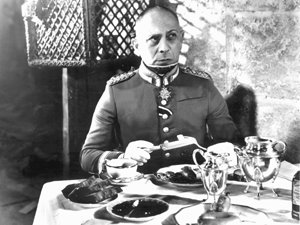CONSIDER
You could fill a whole shelf with movies about the sinking of the Titanic. The first one was made in 1915, just three years after the ship actually sank. A Night To Remember (1958, dir. Roy Ward Baker, written by Eric Ambler from the book by Walter Lord). This one's mostly for the history buffs, I think. Lord's book is an exhaustively researched account of the sinking of the Titanic, and the movie crams as much of what actually happened as possible into its two hours of screen time. I think it's a much better treatment of the subject than the 1997 Titanic, but that's kind of damning with faint praise. Something I didn't know: Fox has produced at least two Titanic films; the first was in 1953 (and won a best screenplay Oscar). Like James Cameron's version, the 1953 film had a fictional love story set on the Titanic: the IMDB has maybe the best ending to any summary on this one: "Their problems soon seem minor when the ship hits an iceberg." That's about the size of it.
So: A Night To Remember. There aren't any fictional subplots in this version, although they do give Second Officer Lightroller all the good lines, whether someone else actually said them or not. The sets look pretty accurate, by which I mean they look just like the sets in Titanic. The grand staircase and first-class dining area get just as much emphasis in this film as the later one: you can see the staircase in the back of this still. The movie opens with a dedication ceremony for the Titanic that never happened, and you get to see the ship dragged out from the drydock into open water. They did this with archival footage of other ships, but it's really impressive. William MacQuitty, who produced the movie, actually saw the Titanic launched. Didn't see it sink, though.
One of the problems with writing anything based on actual events is that people who were there are going to be very concerned with how they appear in the movie. In this movie the big loser is J. Bruce Ismay, the chairman of the White Star Line. I don't remember how he's treated in the 1997 version, but in this one, he's an ineffectual coward who sneaks onto a lifeboat at the last minute. Apparently his wife was none too pleased with this movie, for good reason. Everyone else comes off all right, though. My favorite character is Thomas Andrews, the designer of the ship. His last scene in the first class dining room is the one point where the movie achieves a real sense of tragedy. An honorable mention goes to the ship's baker, who gets increasingly drunker and drunker during the sinking: he has a bottle of whiskey hidden in a dresser drawer and keeps returning to it until his cabin is underwater. As it turns out, this actually happened: despite not being allowed to have alcohol on board per White Star policy, this guy did, and told people about it afterwards. He survived, of course: patron saint of drunks and all that.
Because the filmmakers where very concerned with accuracy and completeness, the movie spends a lot of time on boats that were near the Titanic when she sank, most notably the Californian. This is the boat that was closest, but didn't respond to wireless calls for help or distress flares. Actually, Cameron apparently shot a whole sequence on the Californian as well, but cut it from the film. These guys come off a little worse than Ismay: the captain can't be bothered to get out of bed, the wireless operator goes to sleep and misses the calls for help, and the crewmen who see the flares decide that the Titanic must be celebrating. These guys are my kind of sailors. That said, these sequences kind of kill the momentum of what's going on on the Titanic itself, and I don't think the movie would be worse for cutting them.
The special effects are pretty impressive: there are a lot of model shots that look passable, if not great. In addition, a gigantic replica of the center portion of the ship was constructed on land, and some shots were done with other ships painted to look like the Titanic. At the time this was made, people didn't know the Titanic broke in two before she sank, so that doesn't happen, but through the magic of a tilted set and even more tilted cameras, you do get to see the mad rush to the back of the boat as it starts going down, complete with people hanging from the railings and sliding haphazardly down the deck into the icy water. They filmed the engine room sequences in the last working engine like what was on the Titanic, on a dam somewhere in England. And all the other sequences that you'd expect are here: Captain Smith returns to the bridge to go down with the ship, Thomas Andrews stands in the empty first class lounge listening to the creaks of the ship as it goes down, Guggenheim and his valet dress formally to go down like gentlemen (I wonder what the valet thought of that, though; I think I'd quit at that point), Molly Brown is sturdy, vulgar, and American.
All the detail is kind of the problem, though: the movie feels to me like it's too much just one thing after another. And then this happened, and then that happened, and so on. I think it would be a wonderful movie if you knew a little about the sinking of the Titanic and wanted to learn more, or if you were already a buff. I'm not really in either of those categories, so I can't recommend the movie wholeheartedly.


